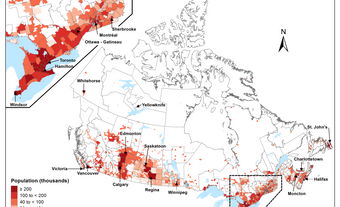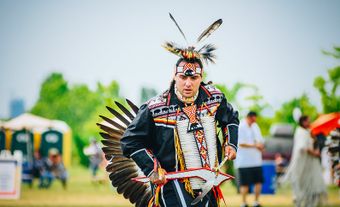Surveys suggest that there may be as many as 2 million lakes in Canada. While some look like small scratches on the country’s surface, many are quite large. Nearly fourteen per cent of the world’s lakes with surface areas over 500 km2 are located in Canada. Below is a list of the largest of these large lakes. The list is ordered by the lake’s total surface area, not just the portions within Canadian borders.
Take the quiz!
Test your knowledge of Canadian geography by taking this quiz, offered by the Citizenship Challenge! A program of Historica Canada, the Citizenship Challenge invites Canadians to test their national knowledge by taking a mock citizenship exam, as well as other themed quizzes.
1. Lake Superior: 82,100 km2
Lake Superior is one of the largest bodies of fresh water in the world, containing more water than all the other Great Lakes combined — 12,100 km3. Called Kitchi-gummi in Anishinaabemowin (meaning “great lake” or “great water”), it was later named Lac Supérieur (meaning “upper”) by the French, as it was the most northern of the Great Lakes.
2. Lake Huron: 59,600 km2
Four interconnected bodies of water form Lake Huron: the main lake, Saginaw Bay, the North Channel and Georgian Bay. Manitoulin Island, the largest island in the world located in a lake, is part of an archipelago at Lake Huron’s northern end. The island is home to six Anishinabek First Nations: Sheguiandah, Aundeck Omni Kaning, M'Chigeeng, Zhiibaahaasing, Sheshegwaning and Wiikwemkoong.
3. Great Bear Lake: 31,328 km2
Great Bear Lake, though third on this list, is the largest lake entirely inside Canadian borders. Located in the Northwest Territories, it is made up of five separate arms, each with their own names: Dease, McTavish, McVicar, Keith and Smith. Great Bear Lake is a part of the Yamoria legends — ancient Dene stories about giant heroes, animals, and living landscapes.
4. Great Slave Lake: 28,568 km2
Great Slave Lake is the second largest lake entirely within Canadian borders. It is located south of Great Bear Lake, in the Northwest Territories. With a maximum depth of 614 m, Great Slave Lake is also North America’s deepest lake. It has two arms, referred to as the North and East arms. The name “Slave” derives from “Slavey” — a word sometimes applied to a major group of Dene people indigenous to the region.
5. Lake Erie: 25,700 km2
Lake Erie is the southernmost and shallowest of the Great Lakes. During the 1960s and early 1970s, it was declared dead. Excess nitrogen and phosphorus in the lake, primarily from detergents and agricultural fertilizers, accelerated the growth of phytoplankton such as algae. The algae grew at the lake’s surface and limited the sunlight and oxygen available to wildlife at the bottom. This wildlife, such as the burrowing mayfly and lake whitefish, disappeared or declined. In 1972, the Great Lakes Water Quality Agreement helped restore Lake Erie, though it still experiences annual dead zones.
6. Lake Winnipeg: 23,750 km2
The Cree called Lake Winnipeg win nipee meaning “muddy water.” English and French maps used a number of different spellings, like Ouynipigon and Winnipeek. Two large sections of the lake’s eastern shoreline are part of Pimachiowin Aki, a UNESCO world heritage site. Pimachiowin Aki means “the land that gives life” in Anishinaabemowin.
7. Lake Ontario: 18,960 km2
Lake Ontario, the smallest of the Great Lakes by surface area, is adjacent to over 55 per cent of the province’s population. The metropolitan areas bordering the lake’s western end, namely St. Catharines-Niagara, Hamilton, Toronto and Oshawa, are known as the Golden Horseshoe. Major factors promoting the settlement and growth of this region have been its productive farmland and access to shipping routes such as the St. Lawrence Seaway and Welland Canal.
8. Lake Athabasca: 7,935 km2
Lake Athabasca is part of the Peace-Athabasca Delta, a biologically diverse wetland west of the lake and about the size of Prince Edward Island. It is an important migration point and nesting area for such bird species as the whooping crane and whistling swan. In addition, 80 per cent of the delta falls within the boundaries of Wood Buffalo National Park, a UNESCO world heritage site and sanctuary for the largest wild bison herd in North America.
9. Reindeer Lake: 6,650 km2
Reindeer Lake, located on the border between northeastern Saskatchewan and northwestern Manitoba, has a heavily indented shoreline and contains numerous small islands. Fishing is an important industry in the area, and sportfishermen are drawn by its clear and deep waters. Regular catches include Northern pike, lake trout, walleye and Arctic grayling.
10. Nettilling Lake: 5,542 km2
Nettilling Lake is located on Baffin Island, Nunavut. It is the largest lake in the world found on an island. Ice-covered for most of the year, only three species of fish have been recorded in its waters: Arctic char and two species of stickleback. The area around the lake and south to Amadjuak Lake is important for caribou.

 Share on Facebook
Share on Facebook Share on X
Share on X Share by Email
Share by Email Share on Google Classroom
Share on Google Classroom



